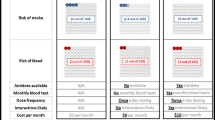Abstract
Consider a finite set of alternatives under risk which have multiple attributes. MARPI is an interactive computer-based procedure to find an efficient choice in the sense of linear expected utility. The choice is based on incomplete information about the decision maker's preferences which is elicited and processed in a sequential way. The information includes qualitative properties of the multivariate utility function such as monotonicity, risk aversion, and separability. Further, in case of an additively separable utility function, bounds on the scaling constants are elicited, and preferences (not necessarily indifferences) between sure amounts and lotteries are asked from the decision maker. The lotteries are Bernoulli lotteries generated by MARPI using special strategies. At every stage of the procedure the efficient set of alternatives is determined with respect to the information elicited so far.
The procedure has been fully implemented on a PC. The paper exhibits the basic ideas of MARPI and some details of its implementation.
Similar content being viewed by others
References
Y. Aksoy, Interactive multiple objective decision making: A bibliography (1965–1988), Manag. Res. News 13 (1990) 1–8.
C.A. Bana e Costa (ed.),Readings in Multiple Criteria Decision Aid (Springer, Berlin, 1990).
J.L. Corner and C.W. Kirkwood, Decision analysis applications in the operations research literature, 1970–1989, Oper. Res. 39 (1991) 206–219.
R. Dyckerhoff, Decomposition of multivariate utility functions in non-additive expected utility theory, J. Multi-Criteria Dec. Anal., to appear.
R. Dyckerhoff, H. Holz and K. Mosler, An efficient algorithm for weak first and second degree stochastic dominance, Institut für Statistik und Quantitative Ökonomik, Universität der Bundeswehr Hamburg (1993).
J.C. Hershey, H.C. Kunreuther and P.J.H. Schoemaker, Sources of bias in assessment procedures for utility functions, Manag. Sci. 28 (1982) 936–954.
J.C. Hershey and P.J.H. Schoemaker, Probability versus certainty equivalence methods in utility measurement, are they equivalent?, Manag. Sci. 31 (1985) 1213–1231.
E. Jacquet-Lagrèze and J. Siskos, Assessing a set of additive utility functions for multicriteria decision-making — the UTA method, Eur. J. Oper. Res. 10 (1982) 151–164.
R. Keeney and H. Raiffa,Decisions with Multiple Objectives: Preferences and Value Tradeoffs (Wiley, New York, 1976).
R. Keeney and A. Sicherman, Assessing and analyzing preferences concerning multiple objectives: An interactive computer program, Behav. Sci. 21 (1976) 173–182.
C.W. Kirkwood and L.C. van der Feltz, Personal computer programs for decision analysis, Vol. 1: User manual, Technical Report, Department of Decision and Information Systems, College of Business, Arizona State University (1986).
V. Lotfi and J.E. Teich, Multicriteria decision making using personal computers, in:Multiple Criteria Decision Support, eds. P. Korhonen, A. Lewandowski and J. Wallenius (Springer, Berlin, 1991) pp. 152–158.
K. Mosler,Entscheidungsregeln bei Risiko: Multivariate stochastische Dominanz (Springer, Berlin, 1982).
K. Mosler, Stochastic dominance decision rules when the attributes are utility independent, Manag. Sci. 30 (1984) 1311–1322.
K. Mosler, Multiattribute utility functions, partial information on coefficients, and efficient choice, OR Spektrum 13 (1991) 87–94.
K. Mosler and M. Scarsini, Some theory of stochastic dominance, in:Stochastic Orders and Decision under Risk, eds. K. Mosler and M. Scarsini (Institute of Mathematical Statistics, Hayward, CA, 1991) pp. 261–284.
K. Murty,Linear and Combinatorial Programming (Wiley, New York, 1976).
R. von Nitzsch and M. Weber, Utility function assessment on a microcomputer: an interactive procedure, Ann. Oper. Res. 16 (1988) 149–160.
R.K. Sarin, Interactive procedures for evaluation of multi-attributed alternatives, Working paper no. 232, Western Management Science Institute, University of California, Los Angeles (1975).
R.K. Sarin, Interactive evaluation and bound procedure for selecting multi-attribute alternatives, in:Multiple Criteria Decision Making, eds. M. Starr and M. Zeleny (North-Holland, New York, 1977) pp. 211–224.
M. Weber, Decision making with incomplete information, Eur. J. Oper. Res. 28 (1987) 44–57.
D. von Winterfeldt and W. Edwards,Decision Analysis and Behavioral Research (Cambridge University Press, Cambridge, 1986).
Author information
Authors and Affiliations
Rights and permissions
About this article
Cite this article
Holz, H., Mosler, K. An interactive decision procedure with multiple attributes under risk. Ann Oper Res 52, 151–170 (1994). https://doi.org/10.1007/BF02032127
Issue Date:
DOI: https://doi.org/10.1007/BF02032127




